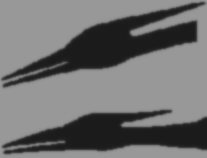This is not about abductions or kidnapping by a non-custodial parent or kids running away from home. I bring up the strangest aspects of some cases of missing children, keeping to ones in the western United States for now. And I admit in the beginning the speculation, for much more information is needed to solve the mysteries of these most unusual cases.
Let’s concentrate, for the moment, on a two-year-old boy, Ronald McGee, who disappeared half a mile northwest of Congress, Arizona. Don’t let the date fool you: February 7, 1942; this kind of missing-child case has continued into recent years.
I learned of Ronald McGee from the Missing 411 – Western United States & Canada by David Paulides, a former law enforcement professional who became an investigative journalist.
“How do we discover something? Seek and ye shall find; knock down somebody who has found something and the door to truth can slam shut against your nose.” That’s what I wrote in the fourth edition of Searching for Ropens and Finding God. I also wrote, “Not everybody embraces a live pterodactyl.” For those who have never previously known about reports of modern pterosaurs, the following is premature, and I will not take up space here with an introduction to the investigations my associates and I have conducted over many years. For those who know something about the ropen, please keep reading.
The case of Ronald McGee
He was playing in a small wash with his four-year-old brother on that cold February morning. Ronald did not return home with his brother, which must have alarmed their mother. A search found no sign of the two-year-old, a search that lasted four days and included airplanes, tracking dogs, and over two hundred volunteers and professional searchers, no sign until the fourth day.
The following statement was ascribed to the local sheriff:
It’s just like the earth opened up and swallowed him.
Over eleven miles away they eventually found the child’s body. It was badly scratched and torn, on the side of Tenderfoot Peak. The author of Missing 411 – Western United States & Canada stated that what happened to the boy “is a modern-day mystery.”
Other missing children
As of December 3, 2014, I have read only half of David Paulides’s book, but I have begun to see something that could explain some of these cases. When a body is eventually found, some articles of clothing are missing. It may be one shoe or the pants or sweater. The author also has noticed strange distances, which are especially weird for small children like two-year-old Ronald. Some toddlers are found miles from where they went missing, too far for those youngsters to walk on their own. There is an unpleasant explanation for some of the disappearances.
A ropen may go bad on occasion, meaning it will attack a person. This is probably rare when compared with all the ones that continue to confine their hunting to bats or fish or carrion at night. But if a large ropen were to make it a habit to attack children, it would sometimes not get a firm grip, keeping hold of a shoe or pants or sweater but allowing the human to fall away, escaping the flying monster but not always escaping the brutality of the fall. That would explain the odd items of missing clothing from a body or living found-person during cold weather.
So what about those who are found still living? Some of them have been found in berry patches, which may explain, perhaps, how they survived: The bushes may have cushioned their falls.
###
.
Missing Persons in Western USA
Those who know about eyewitness reports of ropens need little persuasion to be careful in open areas of wilderness. The automobiles of both Mayo and Tolhurst were found at or near the Donnell Vista, an open area overlooking a lake. Especially do not allow children to ever be alone in such an open area above a body of water. In addition, adults should be aware of anything that might be flying overhead.
Jonathan Whitcomb’s book on ropens
The creatures have many names: seklo-bali, duwas, wawanar, indava, kor, kundua. In Papua New Guinea, natives in isolated communities speak in village languages numbering in the hundreds, yet many natives carry a common fear in the dark: a huge glowing creature flying in the night. Natives on Umboi Island call it “ropen.”
The “pterodactyl attacks” do not seem to come just from the imagination of the author of Bird From Hell, although he displays a keen sense of imagination in his writing (not necessarily in any negative sense of “imagination”). He reports quite a few cases in which residents of a sparsely-populated area of British Columbia have been attacked at night by a large flying creature.
Searching for living pterosaurs in southwest Pacific
The appendage at the back of the head of the huge flying creature caught Hodgkinson’s attention. He was interviewed in 2004, by Jonathan Whitcomb, through emails, phone calls, and a survey form that Whitcomb had prepared. Hodgkinson choose from among various silhouettes of possible head crest lengths (and other variations of appearance), and the final resulting composite of the head was not like any bat.
.



